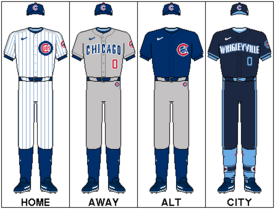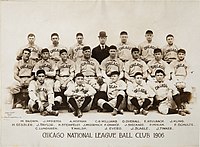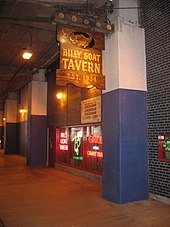Chicago Cubs theme by wallbc01
Download: ChicagoCubs.p3t

(1 background)
| Chicago Cubs | |||||
|---|---|---|---|---|---|
| |||||
| |||||
| Major league affiliations | |||||
| |||||
| Current uniform | |||||
 | |||||
| Retired numbers | |||||
| Colors | |||||
| Name | |||||
| Other nicknames | |||||
| |||||
| Ballpark | |||||
| Major league titles | |||||
| World Series titles (3) | |||||
| NL Pennants (17) | |||||
| NA Pennants (1) | |||||
| Central Division titles (6) | |||||
| East Division titles (2) | |||||
| Wild card berths (3) | |||||
| Front office | |||||
| Principal owner(s) | Thomas S. Ricketts Laura Ricketts Pete Ricketts Todd Ricketts Joe Ricketts | ||||
| President of baseball operations | Jed Hoyer | ||||
| General manager | Carter Hawkins | ||||
| Manager | Craig Counsell | ||||
| Mascot(s) | Clark the Cub | ||||
| Website | mlb.com/cubs | ||||
The Chicago Cubs are an American professional baseball team based in Chicago. The Cubs compete in Major League Baseball (MLB) as part of the National League (NL) Central Division. The club plays its home games at Wrigley Field, which is located on Chicago's North Side. They are one of two major league teams based in Chicago, alongside the American League (AL)’s Chicago White Sox. The Cubs, first known as the White Stockings, were a founding member of the NL in 1876, becoming the Chicago Cubs in 1903.[3][4]
Throughout the club's history, the Cubs have played in a total of 11 World Series. The 1906 Cubs won 116 games, finishing 116–36 and posting a modern-era record winning percentage of .763, before losing the World Series to the Chicago White Sox ("The Hitless Wonders") by four games to two. The Cubs won back-to-back World Series championships in 1907 and 1908, becoming the first major league team to play in three consecutive World Series, and the first to win it twice. Most recently, the Cubs won the 2016 National League Championship Series and 2016 World Series, which ended a 71-year National League pennant drought and a 108-year World Series championship drought,[5] both of which are record droughts in Major League Baseball.[6][7] The 108-year drought was also the longest such occurrence in all major sports leagues in the United States and Canada.[5][8] Since the start of divisional play in 1969, the Cubs have appeared in the postseason 11 times through the 2023 season.[9][10]
The Cubs are known as "the North Siders", a reference to the location of Wrigley Field within the city of Chicago, and in contrast to the White Sox, whose home field (Guaranteed Rate Field) is located on the South Side.
The Cubs won the Laureus World Team of the Year in 2017.[11]
Through 2023, the franchise has played the most games in MLB history, with an all-time regular season record of 11,244–10,688–161 (.513).[12]
History[edit]
Early club history[edit]
1876–1902: A National League[edit]

The Cubs began in 1870 as the Chicago White Stockings, playing their home games at West Side Grounds.
Six years later, they joined the National League (NL) as a charter member. In the runup to their NL debut, owner William Hulbert signed various star players, such as pitcher Albert Spalding and infielders Ross Barnes, Deacon White, and Adrian "Cap" Anson. The White Stockings quickly established themselves as one of the new league's top teams. Spalding won forty-seven games and Barnes led the league in hitting at .429 as Chicago won the first National League pennant, which at the time was the game's top prize.
After back-to-back pennants in 1880 and 1881, Hulbert died, and Spalding, who had retired from playing to start Spalding sporting goods, assumed ownership of the club. The White Stockings, with Anson acting as player-manager, captured their third consecutive pennant in 1882, and Anson established himself as the game's first true superstar. In 1885 and 1886, after winning NL pennants, the White Stockings met the champions of the short-lived American Association in that era's version of a World Series. Both seasons resulted in matchups with the St. Louis Brown Stockings; the clubs tied in 1885 and St. Louis won in 1886. This was the genesis of what would eventually become one of the greatest rivalries in sports. In all, the Anson-led Chicago Base Ball Club won six National League pennants between 1876 and 1886. By 1890, the team had become known the Chicago Colts,[13] or sometimes "Anson's Colts", referring to Cap's influence within the club. Anson was the first player in history credited with 3,000 career hits. In 1897, after a disappointing record of 59–73 and a ninth-place finish, Anson was released by the club as both a player and manager.[14] His departure after 22 years led local newspaper reporters to refer to the Colts as the "Orphans".[14]
After the 1900 season, the American Base-Ball League formed as a rival professional league. The club's old White Stockings nickname (eventually shortened to White Sox) was adopted by a new American League neighbor to the south.[15]
1902–1920: A Cubs dynasty[edit]

In 1902, Spalding, who by this time had revamped the roster to boast what would soon be one of the best teams of the early century, sold the club to Jim Hart. Referencing the youth of the team's roster, the Chicago Daily News called the franchise the Cubs in 1902; it officially took the name five years later.[16][17] During this period, which has become known as baseball's dead-ball era, Cub infielders Joe Tinker, Johnny Evers, and Frank Chance were made famous as a double-play combination by Franklin P. Adams' poem "Baseball's Sad Lexicon". The poem first appeared in the July 18, 1910, edition of the New York Evening Mail. Mordecai "Three-Finger" Brown, Jack Taylor, Ed Reulbach, Jack Pfiester, and Orval Overall were several key pitchers for the Cubs during this time period. With Chance acting as player-manager from 1905 to 1912, the Cubs won four pennants and two World Series titles over a five-year span. Although they fell to the "Hitless Wonders" White Sox in the 1906 World Series, the Cubs recorded a record 116 victories and the best winning percentage (.763) in Major League history. With mostly the same roster, Chicago won back-to-back World Series championships in 1907 and 1908, becoming the first Major League club to play three times in the Fall Classic and the first to win it twice. However, the Cubs would not win another World Series until 2016; this remains the longest championship drought in North American professional sports.

The next season, veteran catcher Johnny Kling left the team to become a professional pocket billiards player. Some historians think Kling's absence was significant enough to prevent the Cubs from also winning a third straight title in 1909, as they finished 6 games out of first place.[18] When Kling returned the next year, the Cubs won the pennant again, but lost to the Philadelphia Athletics in the 1910 World Series.
In 1914, advertising executive Albert Lasker obtained a large block of the club's shares and before the 1916 season assumed majority ownership of the franchise. Lasker brought in a wealthy partner, Charles Weeghman, the proprietor of a popular chain of lunch counters who had previously owned the Chicago Whales of the short-lived Federal League. As principal owners, the pair moved the club from the West Side Grounds to the much newer Weeghman Park, which had been constructed for the Whales only two years earlier, where they remain to this day. The Cubs responded by winning a pennant in the war-shortened season of 1918, where they played a part in another team's curse: the Boston Red Sox defeated Grover Cleveland Alexander's Cubs four games to two in the 1918 World Series, Boston's last Series championship until 2004.
Beginning in 1916, Bill Wrigley of chewing-gum fame acquired an increasing quantity of stock in the Cubs and by 1921, he was the majority owner.[19] Meanwhile, Bill Veeck, Sr. began his tenure as team president in 1919. Veeck would hold that post throughout the 1920s and into the 1930s. The management team of Wrigley and Veeck came to be known as the "Double-Bills".[20]
The Wrigley years (1921–1945)[edit]
1929–1938: Every three years[edit]


Near the end of the first decade of the double-Bills' guidance, the Cubs won the NL Pennant in 1929 and then achieved the unusual feat of winning a pennant every three years, following up the 1929 flag with league titles in 1932, 1935, and 1938. Unfortunately, their success did not extend to the Fall Classic, as they fell to their AL rivals each time. The '32 series against the Yankees featured Babe Ruth's "called shot" at Wrigley Field in game three. There were some historic moments for the Cubs as well; In 1930, Hack Wilson, one of the top home run hitters in the game, had one of the most impressive seasons in MLB history, hitting 56 home runs and establishing the current runs-batted-in record of 191. That 1930 club, which boasted six eventual hall of fame members (Wilson, Gabby Hartnett, Rogers Hornsby, George "High Pockets" Kelly, Kiki Cuyler and manager Joe McCarthy) established the current team batting average record of .309. In 1935 the Cubs claimed the pennant in thrilling fashion, winning a record 21 games in a row in September. The '38 club saw Dizzy Dean lead the team's pitching staff and provided a historic moment when they won a crucial late-season game at Wrigley Field over the Pittsburgh Pirates with a walk-off home run by Gabby Hartnett, which became known in baseball lore as "The Homer in the Gloamin'".[22]
After the "Double-Bills" (Wrigley and Veeck) died in 1932 and 1933 respectively, P.K. Wrigley, son of Bill Wrigley, took over as majority owner. He was unable to extend his father's baseball success beyond 1938, and the Cubs slipped into years of mediocrity, although the Wrigley family would retain control of the team until 1981.[23]

1945: "The Curse of the Billy Goat"[edit]

The Cubs enjoyed one more pennant at the close of World War II, finishing 98–56. Due to the wartime travel restrictions, the first three games of the 1945 World Series were played in Detroit, where the Cubs won two games, including a one-hitter by Claude Passeau, and the final four were played at Wrigley. The Cubs lost the series, and did not return until the 2016 World Series. After losing the 1945 World Series to the Detroit Tigers, the Cubs finished with a respectable 82–71 record in the following year, but this was only good enough for third place.
In the following two decades, the Cubs played mostly forgettable baseball, finishing among the worst teams in the National League on an almost annual basis. From 1947 to 1966, they only notched one winning season. Longtime infielder-manager Phil Cavarretta, who had been a key player during the 1945 season, was fired during spring training in 1954 after admitting the team was unlikely to finish above fifth place. Although shortstop Ernie Banks would become one of the star players in the league during the next decade, finding help for him proved a difficult task, as quality players such as Hank Sauer were few and far between. This, combined with poor ownership decisions such as the College of Coaches, and the ill-fated trade of future Hall of Fame member Lou Brock to the Cardinals for pitcher Ernie Broglio (who won only seven games over the next three seasons), hampered on-field performance.
1969: Fall of '69[edit]

The late-1960s brought hope of a renaissance, with third baseman Ron Santo, pitcher Ferguson Jenkins, and outfielder Billy Williams joining Banks. After losing a dismal 103 games in 1966, the Cubs brought home consecutive winning records in '67 and '68, marking the first time a Cub team had accomplished that feat in over two decades.
In 1969 the Cubs, managed by Leo Durocher, built a substantial lead in the newly created National League Eastern Division by mid-August. Ken Holtzman pitched a no-hitter on August 19, and the division lead grew to 8 1⁄2 games over the St. Louis Cardinals and by 9 1⁄2 games over the New York Mets. After the game of September 2, the Cubs record was 84–52 with the Mets in second place at 77–55. But then a losing streak began just as a Mets winning streak was beginning. The Cubs lost the final game of a series at Cincinnati, then came home to play the resurgent Pittsburgh Pirates (who would finish in third place). After losing the first two games by scores of 9–2 and 13–4, the Cubs led going into the ninth inning. A win would be a positive springboard since the Cubs were to play a crucial series with the Mets the next day. But Willie Stargell drilled a two-out, two-strike pitch from the Cubs' ace reliever, Phil Regan, onto Sheffield Avenue to tie the score in the top of the ninth. The Cubs would lose 7–5 in extra innings.[6] Burdened by a four-game losing streak, the Cubs traveled to Shea Stadium for a short two-game set. The Mets won both games, and the Cubs left New York with a record of 84–58 just 1⁄2 game in front. More of the same followed in Philadelphia, as a 99 loss Phillies team nonetheless defeated the Cubs twice, to extend Chicago's losing streak to eight games. In a key play in the second game, on September 11, Cubs starter Dick Selma threw a surprise pickoff attempt to third baseman Ron Santo, who was nowhere near the bag or the ball. Selma's throwing error opened the gates to a Phillies rally. After that second Philly loss, the Cubs were 84–60 and the Mets had pulled ahead at 85–57. The Mets would not look back. The Cubs' eight-game losing streak finally ended the next day in St. Louis, but the Mets were in the midst of a ten-game winning streak, and the Cubs, wilting from team fatigue, generally deteriorated in all phases of the game.[1] The Mets (who had lost a record 120 games 7 years earlier), would go on to win the World Series. The Cubs, despite a respectable 92–70 record, would be remembered for having lost a remarkable 17½ games in the standings to the Mets in the last quarter of the season.


